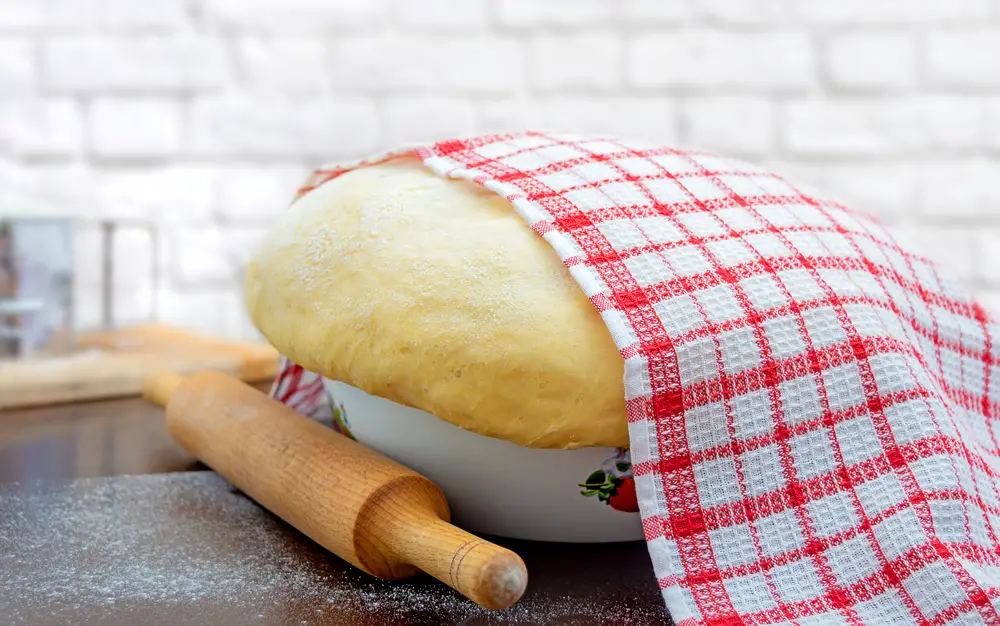When many of us think of pizza, we think of the classic sauce and cheese flatbread that brings a satisfying combination of flavors.
While this kind of pizza is a classic and will remain a fan favorite for many, a unique twist on the dish has become popular within the last few years.
This culinary masterpiece is the sourdough pizza! It is essentially what it sounds like – a selection of sauces and toppings on a sourdough base. In this article, we’ll be exploring the complexities of a sourdough pizza, detailing:
- How a sourdough pizza differs from a normal pie
- What sourdough pizza is made from
- How to make sourdough
- Styles of pizza that use sourdough.
We’ll also be answering a series of frequently asked questions regarding your various sourdough needs. Let’s get started!

Sourdough Pizza vs Normal: Differences
| Sourdough Pizza | Regular Pizza | |
| Texture | Chewy and airy crust, unique texture | Thin, crispy crust |
| Preparation | Slow and patient fermentation process | Quick rise with commercial yeast |
| Crust | Tangy flavor, chewy texture | Traditional crust with less complexity |
| Taste | Depth of flavor, complex taste | Satisfactory taste but less complex |
Texture
Arguably, the main difference between sourdough and normal pizza is the texture.
Normal pizza typically leans towards a thin, crispy crust, whereas its sourdough counterpart offers a chewy and airy texture that simply cannot compare.
This is achieved through a special fermentation process (more on this later in the article). The unique texture of sourdough pizza creates a stunning combination of flavors and mouthfeel, making each bite a memorable experience.
Preparation
The preparation of sourdough pizza is meticulous and can take a while to complete. However, it should be regarded as an art form in itself!
Normal pizza is mostly made with commercial yeast which allows for a quick rise, while sourdough dough requires a slow and patient fermentation process.
The mixture of a sourdough starter culture, flour, and water is naturally fermented with wild yeast and lactic acid bacteria.
This creates a tangy, almost sour (hence the name) flavor – though it also means that the dough can take some time to create.
However, all is worth it in the end when the result is a flavorful and easy-to-digest dough, courtesy of the breakdown of gluten!
Crust
The magic of sourdough pizza lies within its crust. The prolonged fermentation process helps the crust to develop a tangy flavor that complements traditional pizza toppings perfectly! It also gives it a deliciously chewy texture that lingers on the palate.
What makes the crust so great is the organic acids that are produced through the sourdough starter culture.
So, while it may seem tempting to try and speed up the fermentation process, this will only take away from the magnificent experience of sourdough.
Taste
Sourdough pizza has a depth of flavor that simply cannot be found in normal pizza.
The sour base alongside regular pizza toppings such as cheese, meats, vegetables, and spices creates an experience that can only be described as delectable.
This complexity is largely what makes sourdough pizza a culinary masterpiece! While the taste of normal pizza is satisfactory, sourdough pizza is simply on another level of taste.
What is Sourdough Made From?

To understand the flavors behind sourdough, it’s important to grasp its main ingredients:
Flour
A good sourdough pizza is made from high-quality flour. This is important for its texture and taste.
While it may seem insignificant, the type of flour used can make a significant impact on the flour and texture of the base. This is why many bakers opt for high-quality bread flour.
Another popular option is a mixture of bread flour and whole wheat flour that not only creates the required gluten development but can also add to the flavor.
Having a gluten base is essential in making a strong dough that can trap the gases produced during fermentation.
Water
Water may seem pointless; however, it is actually the key to hydrating the flour and activating the fermentation process that makes sourdough pizza oh-so unique!
The amount of water used, and its temperature helps to achieve the desired consistency and fermentation rate of the dough.
The hydration offered by the water also impacts the final texture of the pizza crust.
Apart from this, the water also assists in dissolving the natural enzymes and acids within the flour and also distributes this throughout the mixture.
Starter Culture (Sourdough Starter)
The key to making sourdough pizza is the sourdough starter culture. This is a living mixture of flour and water, fermented with wild yeast and lactic acid bacteria.
The culture provides the rise and signature flavor of the sourdough base, which makes it easily distinguishable from other types of bases such as the normal pizza base commonly found worldwide.
The wild yeast in the starter culture ferments the sugars in the dough, which releases carbon dioxide gas and allows for the dough to rise.
The lactic acid bacteria also help to create the signature tangy flavor that sourdough fans know all too well!
So, How is Sourdough Made?
Crafting sourdough involves a series of precise steps:
Creating the Sourdough Starter
The first step in making sourdough is creating the sourdough starter culture, which is a living combination of flour and water that ferments over time by itself.
The best measurements for a sourdough starter are equal parts flour and water; mix these together and store in a clean container. Loosely cover the container and leave it to sit at room temperature.
Over the next few days, you can ‘feed’ the starter by removing half of the mixture and continuing to add equal parts flour and water. Over time, the mixture will begin to bubble and a sour smell will start to form.
After feeding the starter for about a week, the starter culture is ready for use!
Mixing the Dough
To make the dough mixture, add a portion of your previously created sourdough starter culture and more flour and water (the specific amounts will depend on the recipe).
Mix all of the ingredients together in a large bowl until you have a reasonably sticky dough; it shouldn’t feel as ‘smooth’ as regular dough!
Kneading the Dough
This is a crucial step as it helps to develop the gluten, which will make the consistency more elastic.
Before kneading, sprinkle a small amount of flour over your work surface to stop the dough from sticking!
Knead the dough by stretching it away from yourself, then fold it over and repeat for about 10-15 minutes. The dough should now be smooth with an elastic texture.
Fermentation and Rising
A key step in making a sourdough base is allowing it to ferment.
Take the kneaded dough and put it back into the mixing bowl. Cover it with either a kitchen towel or plastic wrap, then let it sit at room temperature for 6-12 hours (depending on the recipe).
This step is important as it allows the wild yeast and lactic acid bacteria to work their magic!
Shaping the Dough
After the fermentation, the dough will have expanded and it should have developed an airy texture.
Gently remove the dough from the bowl and place it on your working surface. Now is the time to shape the dough into your desired shape!
It’s important to fold and tuck the edges underneath, which creates tension and helps the dough to rise better when baking.
Fermentation (Again)
The second fermentation is important for developing the texture of the dough.
You want to place the dough into a cloth-lined bowl with a light coating of flour. Cover the dough and leave it to ferment for only a couple of hours. Once again, the dough will increase in size and develop a puffy texture.
Let the sourdough cool on a wire rack before adding your desired pizza toppings and reheating. Enjoy!
Baking the Dough
Before you bake the dough, be sure to preheat your oven to a high temperature, around 475-500°F or 245-260°C. It is best to bake sourdough in a cast-iron skillet or a baking stone.
Carefully transfer the dough onto a piece of parchment paper and score the top of the dough to allow it to expand when baking.
Bake the dough for 20-30 minutes, depending on the recipe. You should be able to tell when it’s finished baking when it has golden brown edges and the bread sounds hollow when you tap it on the bottom.
What Styles of Pizza Use Sourdough?

As sourdough pizza has risen in popularity over the last few years, it has found its way into multiple different styles of pie:
Neapolitan Pizza
Neapolitan pizza is renowned for the simple yet high-quality ingredients that make it an iconic style of pizza that many people are familiar with.
Neapolitan pizza traditionally has a thin and soft crust that is slightly charred; having a sourdough base enhances this by giving it a rustic, authentic flavor that complements the toppings well.
New York-Style Pizza
New York-style pizza is known for its thin, foldable slices that make it a fun (yet occasionally challenging) experience for everyone.
When adding a sourdough base, an intriguing twist occurs – pairing the classic New York pizza toppings with a unique flavor experience.
Gourmet and Artisanal Pizzas
Gourmet and artisanal pizzerias have discovered the wonder of sourdough pizza, crafting creative and upscaled dishes with high-quality toppings and a fusion of different flavors and textures.
The sourdough taste adds a certain complexity to the dish, creating a gourmet masterpiece.
California-Style Pizza
California-style pizza carries unconventional topics such as avocado, rocket (arugula), and diverse cheeses. Adding sourdough to this lineup provides a strong foundation for all of these flavors to shine through.
FAQs
Is Sourdough Pizza Healthy?
One of the great things about sourdough pizza is that through the fermentation process, the gluten and phytic acids are broken down, which makes it much easier to digest.
When compared to normal pizza, sourdough pizza has a lower glycemic index, which reduces the impact on your blood sugar levels.
Is Sourdough a New Invention?
Nope! Sourdough has been around for thousands of years and is a tried-and-true method of bread-making. It is known for its unique flavor and easy digestibility.
How Do You Ball Sourdough Pizza Dough?
To ball sourdough pizza dough, begin by dividing the dough into smaller portions.
Then, gently shape the portions of dough into balls and leave them to rest, which will relax the gluten. After this, shape them into traditionally round pizza bases or any other shape you’d like!
What Temperature Do You Cook Sourdough Pizza?
Sourdough is best cooked in a hot, preheated oven at approximately 475 – 500°F or 245-600°C.
You should only cook the dough for around 5-7 minutes; this will help you to achieve a crispy crust!
Why is My Sourdough Pizza Crust Chewy?
While a good sourdough crust should have some kind of a chewy texture, having a crust that is extremely chewy typically means either that the base is undercooked or too much water has been added to the dough.
To fix this, double-check that your oven is hot enough and make sure that the dough has been left to ferment for long enough before cookin
At What Stage Do You Freeze Sourdough Pizza Dough?
You can freeze sourdough pizza dough after it has initially been fermented and shaped. To freeze, wrap the dough tightly in a plastic bag or container. Then, store it in the freezer for convenient future use!
As someone from Long Island, New York, Thomas knows what it takes to make a good pizza. He understands that it’s a combination of high-quality ingredients, well-rounded pizza ovens, and a little bit of love. From the dough of a Neapolitan-style pizza to the wood that powers a wood-fired pizza oven, he has you covered. Thomas’ love of pizza is what got him here and he hopes that you’ll enjoy pizza as much as he does soon.
